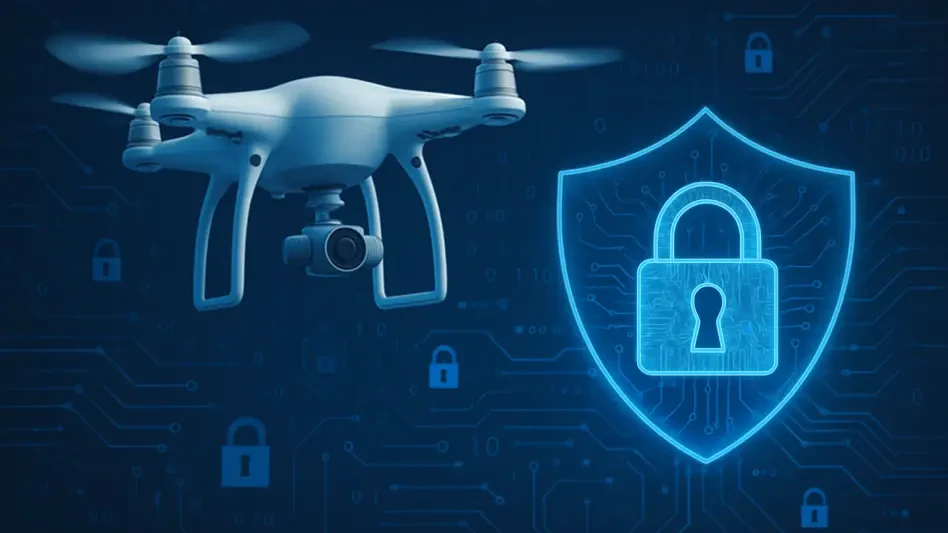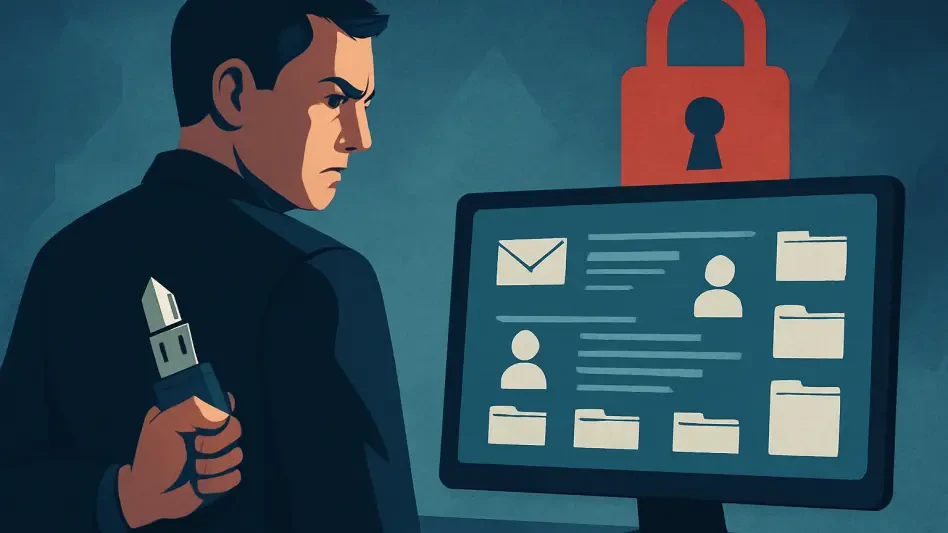In an era where unmanned aerial vehicles (UAVs), commonly known as drones, are revolutionizing industries ranging from defense to delivery services, the looming threat of cyberattacks has become a pressing concern that cannot be ignored. With drones performing critical tasks—such as real-time border surveillance or urgent medical supply drops—their susceptibility to attacks like GPS spoofing or data interception presents a substantial risk to safety and security. The global drone cybersecurity market, valued at $2.45 billion in 2024, is projected to skyrocket to $13.19 billion by 2034, reflecting an urgent need to secure these technologies. This remarkable growth, driven by escalating cyber risks and stringent regulatory demands, underscores a pivotal issue: cybersecurity is no longer just an add-on but a fundamental pillar of drone operations. As reliance on UAVs deepens across diverse sectors, the question arises—how will advancements in cybersecurity redefine their safety, reliability, and potential for innovation in the years ahead?
Rising Threats and Market Expansion
The drone cybersecurity market is experiencing an unprecedented boom, with a compound annual growth rate (CAGR) of 18.28% driving its value toward a projected $13.19 billion by 2034. This rapid expansion is a direct response to the growing array of cyber threats targeting UAVs, such as signal jamming, unauthorized access, and data breaches. Drones are increasingly integral to high-stakes operations, whether it’s military reconnaissance or infrastructure monitoring, where a single breach could lead to disastrous outcomes. The surge in market size highlights a broader recognition that without fortified security, the transformative potential of drones could be severely compromised. Governments and industries alike are prioritizing investments in protective measures, acknowledging that the cost of inaction far outweighs the expense of prevention. This momentum signals a shift where cybersecurity becomes as critical to drone functionality as their physical components.
Beyond the numbers, the urgency to protect drones stems from their expanding role in critical applications. As UAVs handle sensitive data—like military intelligence or proprietary agricultural insights—their appeal as targets for cybercriminals intensifies. The market’s growth reflects a collective push to address vulnerabilities before they are exploited, with stakeholders racing to stay ahead of increasingly sophisticated attacks. Regulatory bodies are stepping in, mandating stricter security protocols that further fuel demand for advanced solutions. This convergence of rising threats and regulatory pressure paints a clear picture: the future of drones hinges on robust cybersecurity frameworks capable of evolving alongside emerging risks. Without such measures, public trust in drone technology could erode, stunting its adoption in vital sectors.
Innovations Driving Drone Security
Technological advancements are reshaping the landscape of drone cybersecurity, offering cutting-edge tools to counter digital threats. Artificial intelligence (AI) is leading the charge, enabling drones to detect and respond to suspicious activities in real time, such as attempted hacks or signal interference. Blockchain technology is also making waves, providing secure, tamper-proof communication channels that safeguard data during transmission. Meanwhile, anti-jamming systems are being refined to protect navigation integrity, ensuring drones remain on course even under attack. These innovations are not just reactive fixes but proactive steps toward building resilience into UAV systems. As these technologies mature, they promise to make drones more autonomous and secure, reducing the need for constant human oversight.
Equally important are the strides in secure firmware updates and autonomous defense mechanisms. These developments ensure that drones can be patched against new vulnerabilities without risking exposure during the process. Autonomous defenses allow UAVs to adapt to threats on the fly, a critical feature for operations in remote or hostile environments. Such advancements are fostering greater confidence in drone technology, encouraging industries to integrate UAVs into more complex and sensitive tasks. The focus on innovation reflects a broader understanding that staying ahead of cybercriminals requires continuous evolution. As these tools become more accessible, they could redefine safety standards, making robust cybersecurity a baseline expectation for all drone operations rather than a premium feature.
Forces Fueling the Need for Protection
The demand for drone cybersecurity is being propelled by a confluence of powerful factors that highlight the stakes involved. At the forefront is the widespread adoption of UAVs across high-risk sectors like defense, where drones often carry classified data, and agriculture, where they collect valuable insights on crop health. These applications make drones lucrative targets for attackers seeking to disrupt operations or steal information. The growing reliance on UAVs for mission-critical tasks amplifies the potential fallout from a cyberattack, pushing industries to prioritize security as a core component of deployment. This trend underscores a shift in perspective—security is no longer an afterthought but a prerequisite for leveraging drone technology effectively.
Another driving force is the escalating sophistication of cyber threats, which are evolving at a pace that challenges even the most advanced defenses. Hackers are deploying complex strategies to manipulate navigation systems or intercept communications, exposing gaps in current protections. Simultaneously, governments worldwide are imposing stringent regulations to ensure safe drone operations, particularly in regions with heavy UAV usage. These mandates compel manufacturers and operators to invest in comprehensive cybersecurity solutions, creating a ripple effect across the market. Together, these dynamics form a compelling case for robust security measures, signaling that the future of drones will be defined by how well they can withstand digital assaults in an increasingly connected world.
Adapting Security to Varied Applications
Drones are permeating nearly every industry, from logistics and transportation to surveillance and manufacturing, each with distinct cybersecurity demands. The market segments into components like software, hardware, and services, tailored to different drone types such as fixed-wing or rotary-wing models. For instance, a drone used in military surveillance requires encryption to protect sensitive data, while one in package delivery needs safeguards against navigation tampering. This diversity in application necessitates a flexible approach to security, where solutions are customized to address specific risks. The challenge lies in ensuring that as drones take on varied roles, their protective measures evolve to match the unique threats each sector faces.
Further complicating the landscape is the integration of drones into critical infrastructure, such as inspecting power grids or monitoring national borders. Breaches in these areas could have far-reaching consequences, from economic losses to security risks, heightening the urgency for specialized cybersecurity. The market’s segmentation reveals a key insight: one-size-fits-all solutions are inadequate in a field as dynamic as drone technology. Instead, developers must focus on modular, adaptable systems that can be scaled or modified based on operational context. This tailored approach not only mitigates risks but also enhances the reliability of drones, ensuring they can perform their intended functions without fear of compromise. The future will likely see even greater specialization in security protocols as drone applications continue to expand.
Regional Influences and Policy Impact
Geographic variations significantly influence the trajectory of drone cybersecurity, with different regions adopting distinct approaches based on policy and economic priorities. North America and Europe stand out as leaders, driven by rigorous regulatory frameworks that mandate high security standards for drone operations. These policies, often backed by government initiatives, ensure that operators prioritize cybersecurity, setting a benchmark for others to follow. The emphasis on compliance in these regions has accelerated the development and adoption of advanced protective technologies, positioning them at the forefront of market growth. Such regulatory clarity provides a stable foundation for innovation, encouraging investment in robust solutions.
In contrast, the Asia-Pacific region is emerging as a critical growth area, fueled by the rapid integration of drones into agriculture, logistics, and urban planning. While regulatory frameworks here are still evolving, increasing government focus on cybersecurity is spurring demand for protective measures. Economic growth and technological adoption in countries like China and India are further amplifying this trend, creating a fertile ground for market expansion. These regional differences highlight a universal truth: while the need for drone security transcends borders, the pace and nature of implementation are shaped by local conditions. Harmonizing these disparities through international collaboration could be a key step toward establishing global standards for UAV protection.
Navigating Growth Amid Challenges
The drone cybersecurity sector brims with opportunity, particularly as technologies like AI and blockchain unlock new ways to fortify UAVs against digital threats. Emerging markets, where drone usage is on the rise, present vast potential for security providers to tap into unmet needs. The growing application of drones in critical infrastructure—think energy grids or disaster response—further amplifies the demand for cutting-edge solutions that can prevent catastrophic breaches. These prospects signal a vibrant future where cybersecurity could become a catalyst for expanding drone capabilities, enabling safer and more ambitious deployments across industries. Capitalizing on these openings will require strategic foresight and investment in scalable technologies.
Yet, significant hurdles stand in the way of this growth, demanding careful navigation. The high cost of implementing advanced cybersecurity measures often poses a barrier, especially for smaller operators with limited budgets. Additionally, the rapid evolution of drone technology frequently outpaces the development of corresponding security solutions, leaving gaps that attackers can exploit. Regulatory inconsistencies across regions add another layer of complexity, making it difficult to standardize practices on a global scale. Addressing these challenges will be essential to ensure that the promise of drone technology is not undermined by vulnerabilities. Finding a balance between innovation, affordability, and regulatory alignment will shape how effectively cybersecurity can support the future of UAVs.
Charting the Path Forward
Reflecting on the journey of drone cybersecurity, it becomes evident that the sector has already made significant strides in addressing the digital threats facing UAVs. By integrating groundbreaking technologies like AI and blockchain, stakeholders have laid a strong foundation for protecting drones across diverse applications. The market’s remarkable growth trajectory, driven by rising risks and regulatory mandates, has underscored the urgency of these efforts over recent years. Challenges such as high costs and inconsistent policies have been acknowledged, prompting a push for more accessible and harmonized solutions.
Looking ahead, the focus must shift to actionable strategies that build on past progress. Collaboration between governments, industry leaders, and tech innovators should aim to create affordable security frameworks that do not exclude smaller players. Developing global standards for drone cybersecurity could help bridge regional gaps, ensuring consistent protection worldwide. Investing in research to anticipate future threats will also be crucial, as will educating operators on best practices. These steps promise to solidify cybersecurity as the backbone of drone technology, enabling UAVs to reach their full potential in a secure and sustainable manner.








